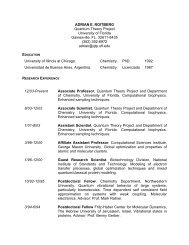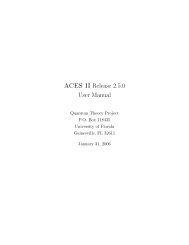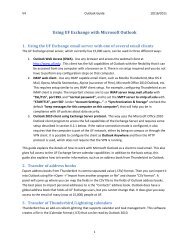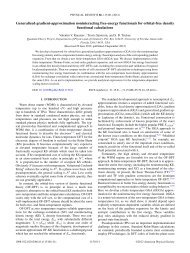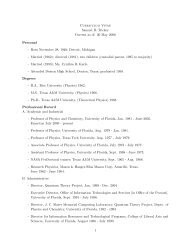gauge-including atomic orbitals (GIAOs) to ensure exact gauge-invariance. Other featuresinclude the direct calculation of electronic excitation energies using the Tamm-Dancoff (orconfiguration interaction singles) model (CIS), the random-phase approximation (RPA), theequation-of-motion coupled-cluster approach (EOM-CC) and similarity transform-equationof-motion(STEOM), and molecular ionization potentials and electron affinities with EOM,STEOM, and Fock-space coupled-cluster methods. Transition moments between groundand excited states can be calculated for all of the methods, as well as selected excited stateproperties. The excited state geometry optimization and frequency calculations employ theanalytical gradients capabilities available for the EOM and STEOM methods.The programs collectively known as <strong>ACES</strong> <strong>II</strong> began development in early 1990, and thefirst <strong>version</strong> of the code was written by J.F. Stanton, J. Gauss, J.D. Watts, W.J. Lauderdale,and R.J. Bartlett. Program development is continuing, and the capabilities as well as thecontributors to the development of the <strong>ACES</strong> <strong>II</strong> program system are continually increasing.At present, there are more than 30 member executables, each of which performs awell-defined function and communicates with the rest of <strong>ACES</strong> <strong>II</strong> through stored files. The<strong>ACES</strong> <strong>II</strong> program system has been interfaced with external programs such as MOLCAS andGAMESS. The primary function of the MOLCAS and GAMESS interfaces is to provide integraland integral derivative programs that are more efficient and have direct capabilities tocomplement the functionalities of the locally modified <strong>version</strong> of vmol, vprops, and vdintprograms. A complete replacement of these member executables is not yet feasible since thespecialized integrals such as Gauge-origin-independent (GIAO) integrals and NMR spin-spincoupling operator integrals are only available in vmol, vprops, and vdint. <strong>ACES</strong> <strong>II</strong> canalso generate interfaces to graphical programs such as MOLDEN and gOpenMol, wave functionanalysis codes such as Natural Bond Orbital (NBO), and semi-emperical programs suchas HyperChem, NDDO, and MOPAC. The <strong>ACES</strong> <strong>II</strong> distribution comes with these capabilities;however, <strong>ACES</strong> <strong>II</strong> developers are not responsible for distributing or maintaining theexternal programs. Having independent licenses for external programs along with <strong>ACES</strong> <strong>II</strong>will allow users to take full advantage of this functionality.Since <strong>ACES</strong> <strong>II</strong> is the product of academic research group, and not a software company,we are unable to guarantee that all results obtained with it are correct. Although we havemade great progress in removing serious errors from the codes, problems may still occurand should be reported to aces2@qtp.ufl.edu. Any suggestions for improving the input oroutput, “wish-lists” for features, or other comments may also be sent to this address.3.1 Overview of capabilities of <strong>ACES</strong> <strong>II</strong>The general capabilities of <strong>ACES</strong> <strong>II</strong> to determine single point energies, analytical gradients,and analytical hessians are as follows:11
Single point energy calculations:• Independent particle models include RHF, UHF, and ROHF.• Correlation methods utilizing RHF and UHF reference determinants include MBPT(2),MBPT(3), SDQ-MBPT(4), MBPT(4), CCD, CCSD, CCSD(T), CCSD+TQ ∗ (CCSD),CCSD(TQ), CCSDT-1 CCSDT-2, CCSDT-3, QCISD, QCISD(T), QCISD(TQ), UCCS(4),UCCSD(4), CID, and CISD.• Correlation methods that can use ROHF reference determinants include MBPT(2),CCSD, CCSDT, CCSD(T), CCSDT-1, CCSDT-2, and CCSDT-3.• Correlation methods that can use QRHF or Brueckner orbital reference determinantsinclude CCSD, CCSDT, CCSD(T), CCSDT-1, CCSDT-2, and CCSDT-3.• Two-determinant CCSD calculations for open-shell singlet state.• Equation-of-motion CCSD calculation of dynamic polarizabilities (including partitionedscheme)• Equation-of-motion CCSD calculation of NMR spin-spin coupling constants (includingpartitioned scheme).• Partitioned equation-of-motion CCSD calculations of excitation energies.• Kohn-Sham DFT methods combined with a wide selection of density functionals.Analytical gradients:• Independent particle models include RHF, UHF, and ROHF.• Correlation methods utilizing RHF and UHF reference determinants include MBPT(2),MBPT(3), SDQ-MBPT(4), MBPT(4), CCD, CCSD, CCSD+T(CCSD), CCSD(T),CCSDT-1, CCSDT-2, CCSDT-3, QCISD, QCISD(T), UCC(4), UCCSD(4), CID, andCISD.• Correlation methods that can also utilize ROHF reference determinants include MBPT(2),CCSD, and CCSD(T).• Correlation methods that can also utilize QRHF reference determinants include CCSD.• Two-determinant CCSD calculations for open-shell singlet state based on QRHF orbitals.12
- Page 1 and 2: ACES II Release 2.5.0User ManualDRA
- Page 3 and 4: 5.24 cphf . . . . . . . . . . . . .
- Page 5 and 6: 8.1.19 Excited states: ionizations
- Page 7 and 8: A.3.4 *EA EOM, *EA CI, *DEA EOM, *D
- Page 9 and 10: • Equation-of-motion CCSD calcula
- Page 11: 3 IntroductionACES II is a set of p
- Page 15 and 16: 4 Quickstart GuideAt the bare minim
- Page 17 and 18: 5.5 vmol2jaxvmol2ja creates most of
- Page 19 and 20: 5.20 propsxprops computes all of th
- Page 21 and 22: For example, a user might be nursin
- Page 23 and 24: 6 File Structure6.1 ZMATZMAT is the
- Page 25 and 26: 6.10.4 OPTARC/OPTARCBKThe iteration
- Page 27 and 28: 7 File Formats7.1 ZMAT7.1.1 File an
- Page 29 and 30: Line 1 RHF MBPT(2) property calc of
- Page 31 and 32: For groups with ambiguities (D 2 ,
- Page 33 and 34: the Z matrix. Positions 3 ∗ I −
- Page 35 and 36: For example, in a regular hexagonal
- Page 37 and 38: and 31 from the correlated calculat
- Page 39 and 40: Line Fortran format Description1 A8
- Page 41 and 42: hash symbol (#) in the next line to
- Page 43 and 44: 8 Keywords8.1 *ACES2 namelistThe us
- Page 45 and 46: Controls the creation, updating, an
- Page 47 and 48: This keyword can be used to reduce
- Page 49 and 50: DIRECT = (switch) OFFControls wheth
- Page 51 and 52: =MOREAD → JOBARC file=CORE → co
- Page 53 and 54: SCF EXPORDER (previously RPP ORDER)
- Page 55 and 56: [NOTE: Gradients and property calcu
- Page 57 and 58: SAVE INTS = (switch) OFFControls de
- Page 59 and 60: Sets how often the largest T amplit
- Page 61 and 62: 8.1.17 Excited states: affinitiesEA
- Page 63 and 64:
ESTATE SYM=3-1-0-2 specifies that 6
- Page 65 and 66:
8.1.21 PropertiesPROPS = (handle) O
- Page 67 and 68:
8.1.22 Geometry optimization: gener
- Page 69 and 70:
8.1.25 Geometry optimization: integ
- Page 71 and 72:
9 Examples9.1 Single-point calculat
- Page 73 and 74:
9.1.5 Effective core potentialsCRF6
- Page 75 and 76:
OLDAOMOS and transformed to the cur
- Page 77 and 78:
framework. Any other result means t
- Page 79 and 80:
• IOPU controls U matrix printing
- Page 81 and 82:
adding an electron.The keywords suc
- Page 83 and 84:
calculation of chemical shifts can
- Page 85 and 86:
198.890 (tzp/dz), and 197.191 (tzp/
- Page 87 and 88:
H 5 RHX* 2 A 1 TM6H 6 RHX* 2 A 1 T1
- Page 89 and 90:
This example reinforces the default
- Page 91 and 92:
X 1 RN 2 R 1 TDAN 2 R 1 TDA 3 TN 2
- Page 93 and 94:
10 Parallelization10.1 OverviewACES
- Page 95 and 96:
10.2.2 Shared scratch directoriesIf
- Page 97 and 98:
10.3 Examples10.3.1 Parallel finite
- Page 99 and 100:
alias xj=’xjoda -rank $rank -proc
- Page 101 and 102:
11 Troubleshooting11.1 Common mista
- Page 103 and 104:
12 ReferencesOf the many methods cu
- Page 105 and 106:
• J.D. Watts and R.J. Bartlett, J
- Page 107 and 108:
12.4 Analytical second derivatives
- Page 109 and 110:
• M.S.Gordon, J.S.Binkley, J.A.Po
- Page 111 and 112:
Polarization exponents from correla
- Page 113 and 114:
A.2 Kohn-Sham DFT namelistsA.2.1*VS
- Page 115 and 116:
A.3 mrcc namelistsA.3.1A.3.2A.3.3A.
- Page 117 and 118:
exponents are: H, He (0.75); Li (0.
- Page 119 and 120:
svp,dzp,tzp,tzplarge,qz2p,... These
- Page 121 and 122:
Table 1: The number of contracted A
- Page 123 and 124:
Table 1: The number of contracted A
- Page 125 and 126:
Table 1: The number of contracted A
- Page 127 and 128:
Table 2: The number of contracted A
- Page 129 and 130:
Table 2: The number of contracted A
- Page 131 and 132:
Table 3: The number of contracted A
- Page 133 and 134:
CQueue ScriptsWhile nothing prevent
- Page 135 and 136:
Index*ACES2ABCDFULL, 56ABCDTYPE, 55
- Page 137:
TAMP SUM, 57TDHF, 64TRANS INV, 68TR



